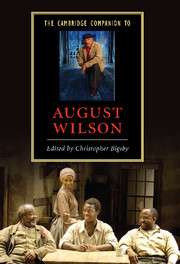Book contents
- Frontmatter
- 1 August Wilson: the ground on which he stood
- 2 Been here and gone
- 3 August Wilson’s relationship to black theatre: community, aesthetics, history and race
- 4 Music and mythology in August Wilson’s plays
- 5 Gem of the Ocean and the redemptive power of history
- 6 Joe Turner’s Come and Gone
- 7 Ma Rainey’s Black Bottom: cutting the historical record, dramatizing a blues CD
- 8 A piano and its history: family and transcending family
- 9 The tragedy of Seven Guitars
- 10 Safe at home?: August Wilson’s Fences
- 11 Two Trains Running: blood on the tracks
- 12 Jitney, folklore and responsibility
- 13 King Hedley II: in the midst of all this death
- 14 Radio Golf: the courage of his convictions - survival, success and spirituality
- 15 Critics on August Wilson
- 16 An interview with August Wilson
- Index
5 - Gem of the Ocean and the redemptive power of history
Published online by Cambridge University Press: 28 January 2008
- Frontmatter
- 1 August Wilson: the ground on which he stood
- 2 Been here and gone
- 3 August Wilson’s relationship to black theatre: community, aesthetics, history and race
- 4 Music and mythology in August Wilson’s plays
- 5 Gem of the Ocean and the redemptive power of history
- 6 Joe Turner’s Come and Gone
- 7 Ma Rainey’s Black Bottom: cutting the historical record, dramatizing a blues CD
- 8 A piano and its history: family and transcending family
- 9 The tragedy of Seven Guitars
- 10 Safe at home?: August Wilson’s Fences
- 11 Two Trains Running: blood on the tracks
- 12 Jitney, folklore and responsibility
- 13 King Hedley II: in the midst of all this death
- 14 Radio Golf: the courage of his convictions - survival, success and spirituality
- 15 Critics on August Wilson
- 16 An interview with August Wilson
- Index
Summary
Gem of the Ocean (2003) ends with the benediction and instruction offered by Mr Eli, Aunt Ester's gatekeeper, over the newly deceased body of his friend Solly. As he pours a drink and raises it in a toast, he says, 'So live.' It is a noble petition of hope for the future of the gathered community and a purposeful plea for African Americans to live a life founded on personal integrity and committed to the collective struggle for truth. 'So live.' And so ends the beginning of August Wilson's history plays, the first play in his ten-play cycle, set in 1904 at the dawn of the first migration of blacks from the South to the North. Wilson has situated this play at this precise moment just as he has positioned every work within the cycle at critical historical junctures, key transitional moments in the story of Africans in America. Within such moments Wilson reviews the choices that blacks have made in the past. Yet in Gem, as well as his other works, Wilson is not simply reviewing this past and reevaluating history. His project is so much more proactive as he considers how this past now impacts on the African American present.
In Gem of the Ocean, Citizen Barlow is haunted by his past. He comes to the home of Aunt Ester, at 1839 Wylie Avenue in Pittsburgh, seeking her assistance. There he finds her tended by Mr Eli, who maintains and watches over her and Black Mary, who cooks and cleans for her. The desperate Citizen has heard that Aunt Ester has the ability to wash people's souls and, racked with guilt, he badly needs some form of spiritual sustenance and moral forgiveness. In order to help Citizen save himself, Aunt Ester, with assistance from Mr Eli, Black Mary and her friend and suitor Solly, a former conductor on the Underground Railroad, takes him on an eerie, symbolic and spiritual journey, back through time and space, to the City of Bones, a place deep down in the middle of the ocean, where, we are told, African slaves who never made it across have built a kingdom of bones. Through the psychic process of travelling to this city, by confronting his past in this site and making his peace, Citizen Barlow is able to move forward.
- Type
- Chapter
- Information
- The Cambridge Companion to August Wilson , pp. 75 - 88Publisher: Cambridge University PressPrint publication year: 2007
- 3
- Cited by

